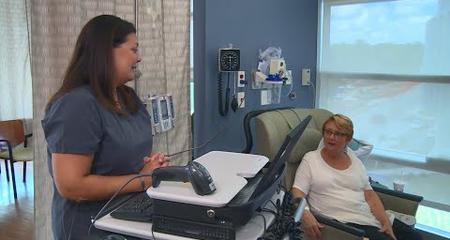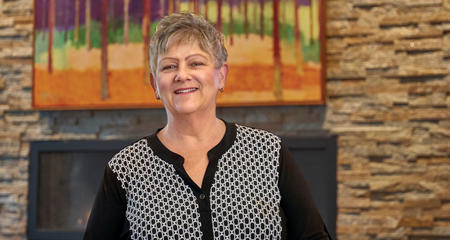Lung surgery is a powerful tool in the fight against lung cancer. It is especially effective when it is determined that all the cancer can be removed. For example, patients with early stage cancers—localized cancers that have not spread beyond the lungs or invaded vital organs—are good candidates for lung surgery. Tumors are classified with T1, T2, T3 and sometimes T4 designations, which describe tumors according to size and location inside the chest. Lymph nodes are described as N0, N1, N2, or N3 depending on their location.
Patients must be healthy enough to tolerate the surgery, so they must undergo lab and other tests, to ensure they are strong enough to withstand surgery. We also perform pulmonary function tests (PFTs) to determine how well the patient’s lungs are working and how well they might function if a portion of lung is removed.
Diagnostic and Therapeutic Surgery for Lung Cancer
Surgery may involve removal of the tumor, sections of the lung that contain the tumor and nearby lymph nodes. Surgery is the most effective treatment for early stage non-small cell lung cancers. For more advanced stages, surgery is often combined with radiation and/or chemotherapy.
Surgery can be diagnostic or therapeutic, and sometimes it is both simultaneously. For example, our thoracic surgeons may perform a wedge resection to remove a suspicious spot so it can be tested or biopsied to see if it is cancer. In most cases, removing the spot or mass is also the best option for treating the cancer.
When surgeons remove the suspicious nodule, the pathologist examines the mass while the patient is still in the operating room. If the mass is cancer, surgeons can continue on and perform a lobectomy to remove the entire lobe of the lung where the mass was located.
Video-Assisted Thoracoscopic Surgery (VATS)
Video-assisted thoracoscopic surgery is our preferred, minimally invasive surgical approach. VATS techniques typically result in less pain, faster recovery and fewer complications for the patient. For cases that are found early, VATS is as effective in treating the cancer as more invasive surgical options. However, some patients, may still need to have a thoracotomy (an open surgical procedure) or a procedure that combines minimally invasive and open techniques. That decision is usually made based on the patient’s surgical history, anatomy and the location of the tumor. Surgical procedures that can be performed with VATS include:
- Wedge resection: removal of a triangle shaped section of a lung, including the suspicious spot or mass and some normal tissue around it. A wedge resection is most effective for a single nodule located in one spot.
- Segmental resection: removal of a section of the lung with the tumor and normal tissue around it.
- Pleurodesis: fluid drainage and procedures to prevent fluid buildup.
- Lobectomy: removal of an entire lobe of the lung. A lobectomy is most effective for spots located in just one lobe.
- Pneumonectomy: removal of the entire lung. This procedure may be done using the traditional, open method or a combination of the open and VATS procedures. We are one of the few centers in the area that offers this procedure.
New VATS Development: Medical College of Wisconsin radiologists have begun a procedure to help surgeons during certain VATS operations. If the mass or nodule is very small or not very solid, radiologists can inject a small amount of iodinated dye into the mass under CT scan guidance. The surgeon uses a fluoroscope in the operating room to look for the dye marker to more easily find the nodule and perform the wedge resection. This technique, which our radiologists learned about from their monitoring of international research, can shorten the procedure and increase the certainty of a successful biopsy. Colored dyes are also used to help find small nodules.
Robotic Surgery
Robotic surgery is also a minimally invasive surgical approach, but it uses different instruments than a standard VATS procedure. Robotic instruments are more sophisticated, and have range of motion is similar to that of a human hand. Optics, magnification and ability to visualize what is being operated on is superior with robotics. Robotic surgery is the first choice for patients with mediastinal masses (located in the area of the chest between the lungs.) However, our thoracic surgeons are still evaluating and reviewing the benefit of robotic surgery for lobectomies and other lung surgeries.
Alternatives to Surgery
When patients are not healthy enough for surgery — even the least invasive procedures, the standard treatment is radiation therapy. Stereotactic Body Radiation Therapy is used in select cases. Alternative treatments being studied include chemotherapy or interventional radiology techniques.
Virtual Visits Are Available
Safe and convenient virtual visits by video let you get the care you need via a mobile device, tablet or computer wherever you are. We’ll gather your medical records for you and get our experts’ input so we can offer treatment options without an in-person visit. To schedule a virtual visit, call 1-866-680-0505.
More to Explore





